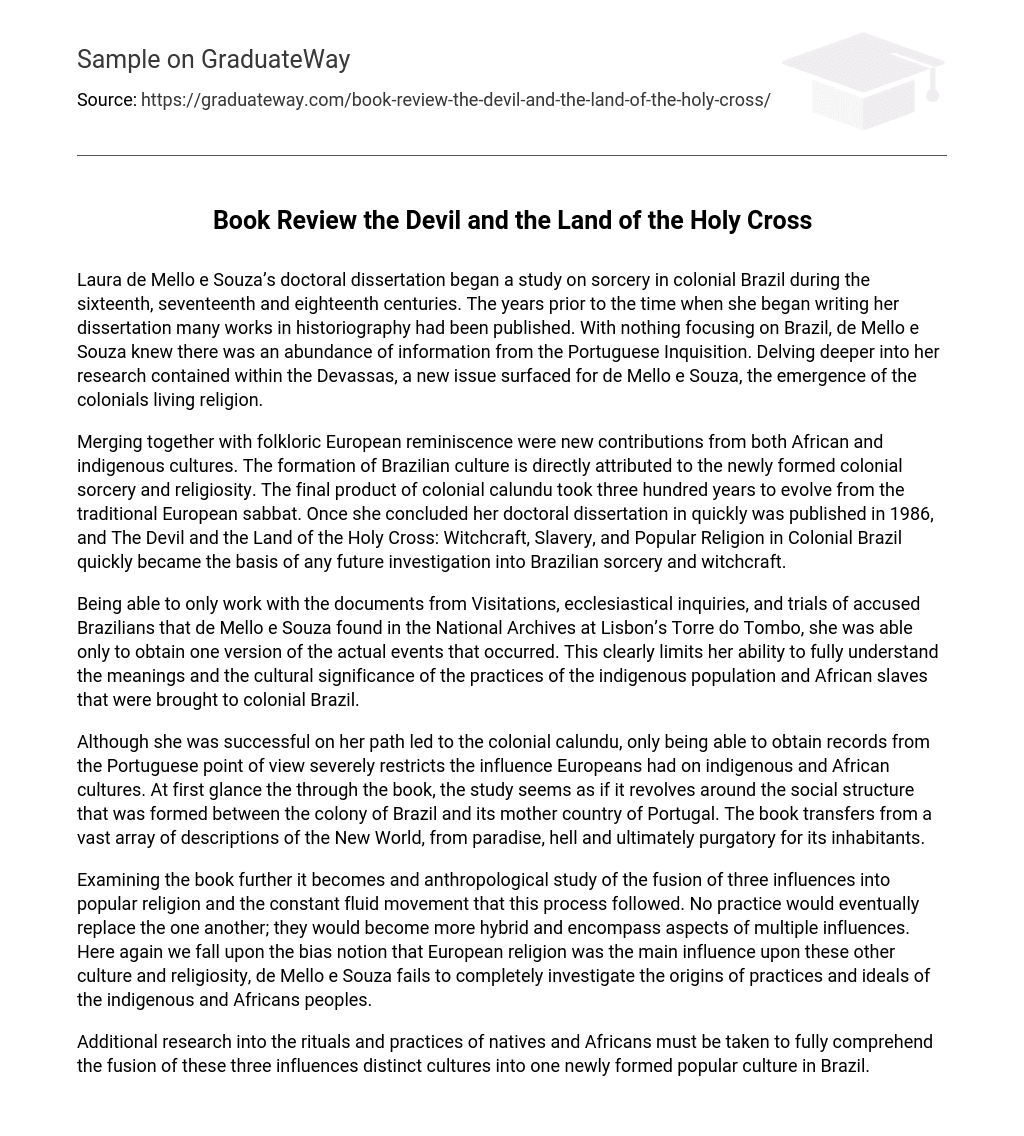Laura de Mello e Souza embarked on her doctoral dissertation, which examined sorcery in colonial Brazil from the sixteenth to the eighteenth century. Before she started writing her dissertation, numerous works on historiography had already been published. However, none of them specifically focused on Brazil. De Mello e Souza recognized the wealth of information available from the Portuguese Inquisition and decided to explore it further. As she delved into her research, a new aspect came to light: the development of religion among the colonial settlers.
Merging together with a mix of European folklore, new elements from both African and indigenous cultures influenced the formation of Brazilian culture. The formation of Brazil’s culture is directly attributed to the combination of colonial sorcery and religiosity. The colonial calundu, which evolved from the traditional European sabbat, took three hundred years to reach its final form. In 1986, her doctoral dissertation was quickly published and became the foundation for any future study on Brazilian sorcery and witchcraft – The Devil and the Land of the Holy Cross: Witchcraft, Slavery, and Popular Religion in Colonial Brazil.
Due to the limitation of only accessing documents from Visitations, ecclesiastical inquiries, and trials of accused Brazilians at Lisbon’s Torre do Tombo National Archives, de Mello e Souza could only acquire one version of the events that took place. This restriction hinders her ability to grasp the complete understanding of the meanings and cultural importance behind the practices of the indigenous population and African slaves brought to colonial Brazil.
Although the author was successful in her research on the colonial calundu, the limitation of only having records from the Portuguese perspective greatly restricts our understanding of the influence Europeans had on indigenous and African cultures. The book primarily focuses on the social structure that developed between Brazil as a colony and Portugal as its mother country. Throughout the book, there is a wide range of descriptions of the New World, portraying it as a paradise, hell, and ultimately purgatory for its inhabitants.
Upon closer examination, the book reveals itself to be an anthropological study exploring the blending of three influences in popular religion. This process of fusion is characterized by constant movement and fluidity. Rather than one practice replacing another, they become more hybrid, incorporating aspects from multiple influences. It is worth noting, however, that there exists a biased assumption that European religion was the primary influence on these other cultures and their religious practices. de Mello e Souza does not thoroughly investigate the origins of the practices and ideals of indigenous and African peoples.
Further study is necessary to fully understand how the fusion of three distinct cultures – natives, Africans, and Brazilians – has shaped popular culture in Brazil. In her book, de Mello e Souza focuses on the stories of individuals who were prosecuted in the final chapter, giving a voice to those who were unable to speak for themselves. By reconstructing these individuals’ lives, she provides insight into the process that these trials followed, from the initial accusation to the eventual trial that determined the fate of each person.
Readings provide insight from firsthand accounts of the trials, revealing a lack of representation and the use of torture to force confessions. The victims, imprisoned in the Inquisition dungeons for years, often did not survive the lengthy trial process. One specific case mentioned involves an accused individual who was driven to madness while awaiting their trial.
Despite their insightful nature, these reports are tainted by the fact that the individuals were coerced into confessing to their accused crimes through torture. This sheds more light on the process the accuser went through during the Inquisition, rather than the actual testimonials of the accused. Without a genuine voice for these individuals, it is impossible to fully comprehend the true essence of their practices and beliefs. After thoroughly analyzing this book from various perspectives, Laura de Mello e Souza successfully proves her thesis that colonial witchcraft was both a complex collage and the source of a new synthesis. She supports her claim with substantial primary source evidence. In the Preface to the first edition, de Mello e Souza acknowledges that she did not review all the records of Brazilian trials involving sorcery from the Inquisition, highlighting the ever-evolving and non-definitive nature of history. By acknowledging this, she accounts for what some may consider incomplete research.
Nevertheless, her research remained biased towards European views and structure. We cannot fully understand the evolution of popular religion in Brazil without acknowledging the impact of indigenous and African ideas, which were modified by European influences. The Inquisitorial documentation portrays the fears and fantasies of Church authorities rather than the actual practices of those accused. At times, de Mello e Souza accepts the accounts described by the accusers as if they were completely accurate.
The book has made a significant contribution to the literary world by providing insight into Brazils religiosity, sorcery, and witchcraft. It serves as a solid foundation for further research on these topics and unanswered questions. However, it primarily focuses on Europeans’ perceptions of popular religion in Brazil, rather than the actual religious practices of the colony’s inhabitants.





